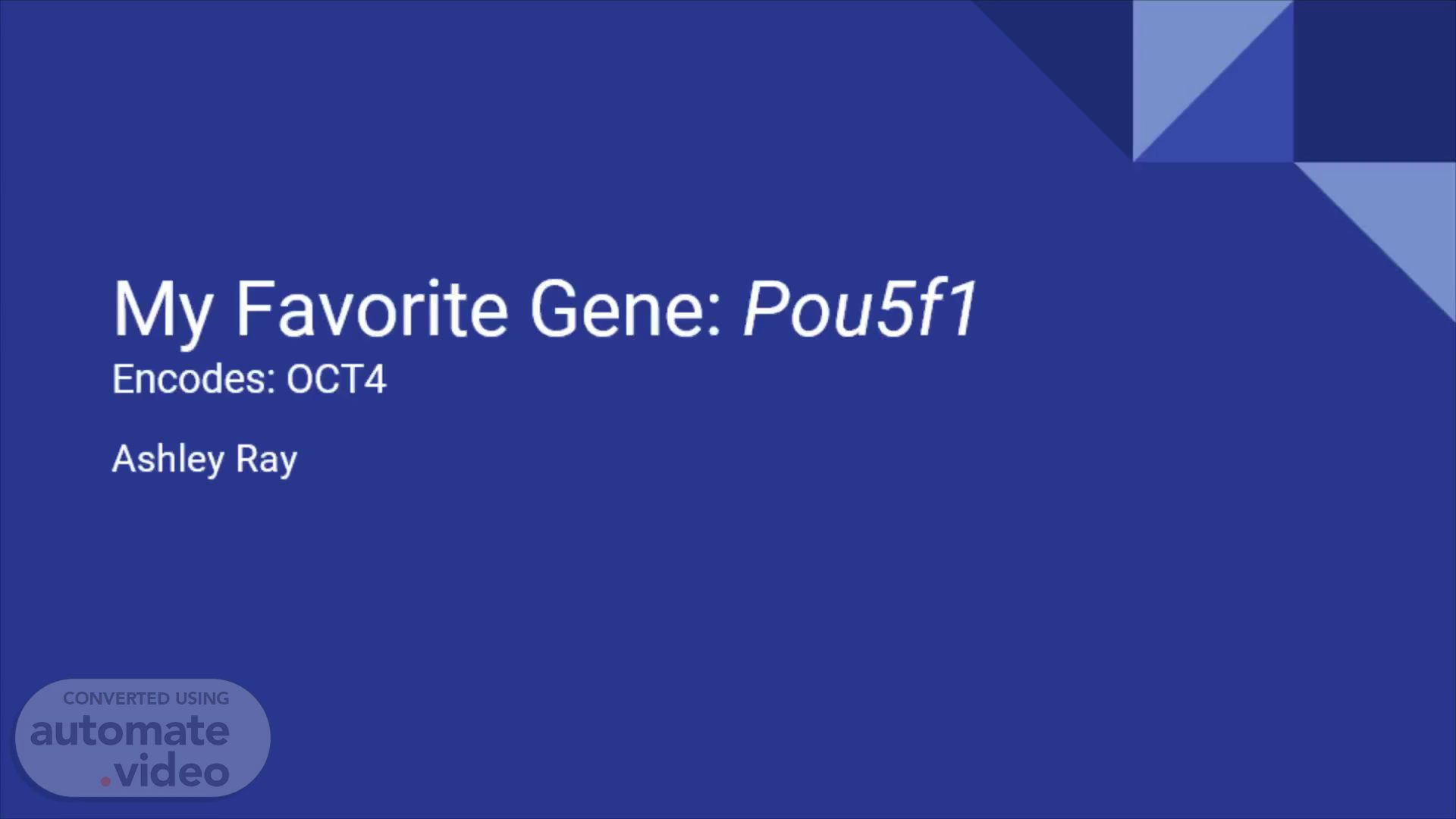Scene 1 (0s)
My Favorite Gene: Pou5f1 Encodes: OCT4. Ashley Ray.
Scene 2 (11s)
Why this gene?. Highly conserved across species DNA binding domain specifically (POU) Function differs among species Key to early embryonic development Control pluripotency of ESC in mammals Integral for primordial germline survival in mammals Implicated generation/maintenance of cancer stem-like cells Cell proliferation Cell pluripotency Conferring chemoresistance in tumors with OCT4 expression Immortality of cancer cells A ctiavted via DNA repair Used in programing iPS cells In mice and human fibroblasts.
Scene 3 (2m 14s)
The species I first found this gene in. Mouse Pou5f1 gene encodes OCT4 OCT4 controls formation of the ICM from the morula.
Scene 4 (3m 6s)
What is the function of the gene?. Mouse Induces ICM formation Maintains mouse (mammalian) germ cells with Sox2 Human Maintain ES cell pluripotency Part of the family of Yamanaka factors Implicated in cancer stem-like cells (CSCs) Zebrafish Endoderm development with casanova Promotes bmp expression.
Scene 5 (4m 28s)
Necessity and sufficiency. Mouse Both necessary and sufficient for induction of the ICM Necessary but not sufficient (works with Sox2) to maintain germ cell pluripotency Human Necessary for all functions Oct4 depends also on NANOG and SOX2 expression for pluripotency maintenance Implicated in the cancer stem-like pathway but not proven to be sufficient for inducing the phenotype Zebrafish Necessary but not sufficient for development of endoderm.
Scene 6 (5m 39s)
CSCs. I.S Mdtiuddin, et aL : Notch pathway (1) WNT pathway APC (2) P13K pathway AKT FOXCI ATG7 (3) HIF2-a NF-KB su ß-catenin ON T CF OCT4 TALE/Cas9 TGF-ß1 (4) su (5) VEGFCNEGFR3.
Scene 7 (7m 7s)
Function of Pou5f1 gene product Oct4. Oct4 is a transcription factor with a POU DNA binding domain. Located on chromosome 6 in humans and chromosome 17 in mice. Oct4 is a transcription factor that is responsible for activating pluripotency genes in the mammalian germ line, and also embryonic development. Oct4 forms a complex with SOX proteins in humans for activation of embryonic development genes. Oct4 in CSCs is controlled by the WNT pathway. TGF beta is the direct activator of Oct4 expression in CSCs. SOX2 and NANOG genes are upregulators of Oct4. PI3K pathway also identified as an upstream activator.
Scene 8 (8m 34s)
OCT4 in Cancer. OCT4 indicates poor prognosis Interestingly CRISPR/Cas9 maybe able to induce OCT4 activation due to double stranded breaks Both human and mice somatic cells Chemotherapy may also be an activator of OCT4 Cells expressing OCT4 are chemotherapy resistant OCT4 knockdown was successful at reversing chemo resistance OCT4 is linked to reprogramming mesenchymal somatic cells Unique ability to change phenotype leads to cancer cell heterogeneity.
Scene 9 (9m 55s)
Human Ortholog. Pou5f1 is found in the human genome as well Located on chromosome 6 Similar to mice this gene has 5 exon regions Several variants of OCT4 produced via alternative splicing.
Scene 10 (10m 21s)
References. Erenpreisa, Jekaterina, and Mark S. Cragg. "Three steps to the immortality of cancer cells: senescence, polyploidy and self-renewal." Cancer cell international 13.1 (2013): 1-12. Mohiuddin, Ismail S., Sung-Jen Wei, and Min H. Kang. "Role of OCT4 in cancer stem-like cells and chemotherapy resistance." Biochimica et Biophysica Acta (BBA)-Molecular Basis of Disease 1866.4 (2020): 165432. “UCSC Genome Browser on Human Dec. 2013 (GRCh38/hg38) Assembly.” Mouse MM10 CHR17:35,506,032-35,510,777 UCSC Genome Browser V423 , University of California Santa Cruz Genomics Institute, https://genome.ucsc.edu/cgi-bin/hgTracks?db=mm10&lastVirtModeType=default&lastVirtModeExtraState=&virtModeType=default&virtMode=0&nonVirtPosition=&position=chr17%3A35506032-35510777&hgsid=1230036407_Qx69VR2pvGqziJnPuZQbHvN0zfoM. “UCSC Genome Browser on Mouse Dec. 2011(GRCh38/mm10) Assembly.” UCSC Genome Browser V423 , University of California Santa Cruz Genomics Institute, https://genome.ucsc.edu/cgi-bin/hgTracks?db=mm10&lastVirtModeType=default&lastVirtModeExtraState=&virtModeType=default&virtMode=0&nonVirtPosition=&position=chr17%3A35506032%2D35510777&hgsid=1230036407_Qx69VR2pvGqziJnPuZQbHvN0zfoM.
